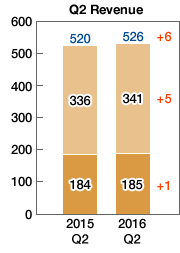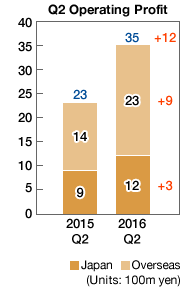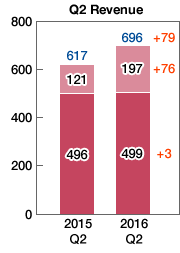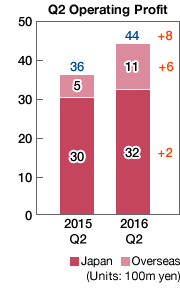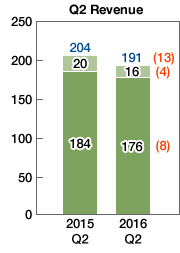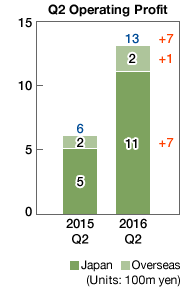News Release
Financial results
FUJI OIL HOLDINGS
Announcement of the Settlement of Accounts for the Second Quarter of the Year Ending March 2017
2016.11.8
(Note) Figures shown have been rounded down to the nearest million yen
Our settlement of accounts for the second quarter of the year ending March 2017 was announced on the afternoon of Tuesday, November 8 at the Tokyo Stock Exchange Press Club. An outline of the accounts is presented below.
Consolidated Results for the Second Quarter of the Year Ending March 2017 (April 1, 2016 to September 30, 2016)
Consolidated operating results (total)
(% is in comparison to the previous year)
| Revenue | Operating profit | Ordinary profit | Net income attributable to shareholders of parent company for quarter | |||||
|---|---|---|---|---|---|---|---|---|
| (millions of yen) | (%) | (millions of yen) | (%) | (millions of yen) | (%) | (millions of yen) | (%) | |
| Second quarter of the year ending March 2017 | 141,361 | 5.4 | 9,196 | 42.9 | 9,063 | 52.9 | 6,153 | 69.9 |
| Second quarter of the year ending March 2016 | 134,098 | 4.7 | 6,436 | 0.2 | 5,926 | (7.5) | 3,622 | (22.7) |
- *Comprehensive income:
-
- 2Q for year ending March 2017: -165 million yen (-106.6%)
- 2Q for year ending March 2016: 2,489 million yen (-48.1%)
Overview of the second quarter of the year ending March 2017
The Japanese economy during the company’s first half of the fiscal year saw robust progress in employment and income, and while personal consumption bottomed out, the economy leveled out. With regards to the overseas economy, while the economy of United States expanded moderately, the global economy continues to lack strength due to the increased risk of a downward trend in the European economy attributable to the impact of the UK's decision to leave the European Union (EU), sluggish growth in China and developing countries, and other such factors, leading to a continued state of uncertainty.
Against this backdrop and in line with the fundamental policies of “sustainable management”, “global management”, and “technological management” in our rolling midterm management plan called “Renaissance Fuji 2018” (April 2016 - March 2019), we have been enhancing operational strength through our growth strategy, profit structure reform, and the construction of a supply chain, and engaging in product development meeting the needs of customers while delivering high-functionality ingredients.
As a result, for the first half of the year ending March 2017, we achieved consolidated revenue of 141,361 million yen (increase of 5.4% y-o-y), operating profit of 9,196 million yen (increase of 42.9% y-o-y), ordinary profit of 9,063 million yen (increase of 52.9% y-o-y) and net income attributable to shareholders of parent company of 6,153 million yen (increase of 69.9% y-o-y).
Overviews by division are as follows:
Oils and Fats Processing division
| FY2015 Q2 Total | FY2016 Q2 Total | Comparison to the previous year | ||
|---|---|---|---|---|
| Difference (amount) | Difference (ratio) | |||
| Revenue | 520 | 526 | +6 | +1.2% |
| Operating profit | 23 | 35 | +12 | +53.6% |
Domestically, increased sales amount from frying oil, palm oil for confectionery oils and fats, and hard butters for chocolate led to an increase in income and profit.
Overseas, increased sales of palm oil mainly in the Americas led to an increase in income and profit.
Through these results, this division achieved a sales volume of 52,606 million yen (increase of 1.2% y-o-y) and an operating profit of 3,485 million yen (increase of 53.6% y-o-y).
Confectionery and Bakery Ingredients division
| FY2015 Q2 Total | FY2016 Q2 Total | Comparison to the previous year | ||
|---|---|---|---|---|
| Difference (amount) | Difference (ratio) | |||
| Revenue | 617 | 696 | +79 | +12.8% |
| Operating profit | 36 | 44 | +8 | +22.9% |
In Japan, sales of chocolates for industrial use and chocolates for frozen confectionery grew, resulting in growth in both income and profit.
Overseas, while sales of margarines and shortenings decreased in Southeast Asia, the Brazilian chocolate manufacturing and sales company Harald (which became a consolidated subsidiary in the previous fiscal year) achieved an increase in net sales, leading to increased income and profit.
Through these results, this division achieved a sales volume of 69,625 million yen (increase of 12.8% y-o-y) and an operating profit of 4,366 million yen (increase of 22.9% y-o-y).
Soy Protine Division
| FY2015 Q2 Total | FY2016 Q2 Total | Comparison to the previous year | ||
|---|---|---|---|---|
| Difference (amount) | Difference (ratio) | |||
| Revenue | 204 | 191 | (13) | (6.2%) |
| Operating profit | 6 | 13 | +7 | +118.4% |
While soy protein ingredients increased sales for the health food market robustly, sales for the meat, prepared, and processed foods markets decreased. Soy protein products saw increased sales for instant deep-fried tofu. Soy protein function-enhancing ingredients saw increased sales in products for beverages. Sales decreased for soy milk due to the consolidated subsidiary Toraku Foods taking over sales of soy milk to retailers.
Because of these factors, the division overall saw a decrease in sales, but profitability increased due to business reconstruction and cost reduction resulted in increased profits.
Through these results, this division achieved a sales volume of 19,128 million yen (decrease of 6.2% y-o-y) and an operating profit of 1,344 million yen (increase of 118.4% y-o-y).
Predictions for Consolidated Results for the Year Ending March 2017 (Friday, April 1, 2016 to Friday, March 31, 2017)
Based on recent performance trends, the results forecast announced on May 11, 2016 has been modified as follows.
| Revenue | Operating profit | Ordinary profit | Net income attributable to shareholders of parent company | Net income per share | |
|---|---|---|---|---|---|
| millions of yen (%) | millions of yen (%) | millions of yen (%) | millions of yen (%) | (yen) | |
| Previous forecast (A) | 310,000 | 17,500 | 16,000 | 10,000 | 116.33 |
| Revised forecast (B) | 292,000 | 19,600 | 18,200 | 12,000 | 139.60 |
| Difference (B-A) | (18,000) | 2,100 | 2,200 | 2,000 | - |
| Difference ratio (%) | (5.8) | 12.0 | 13.8 | 20.0 | - |
| (Reference) Results from previous year (Year ending March 2016) | 287,537 | 16,840 | 14,121 | 9,227 | 107.35 |
*Qualitative information regarding forecast consolidated figures
In the consolidated results forecast for the year ending March 2017, revenue has been revised based on the fact that the yen translation for overseas group companies is expected to decrease due to the impact of exchange rates, and profits have been revised based on the company’s results from the first half of the fiscal year and recent performance trends.
*The forecasts above have been made based on information available at the time of this announcement.
The actual results may differ from these forecasts due to various factors.
End of report
More Detail
Overview of Consolidated Profits and Losses
(Units: 100m yen)
| FY2015 Q2 Total | FY2016 Q2 Total | Comparison to the previous year | |||
|---|---|---|---|---|---|
| Difference (amount) | Difference (ratio) | ||||
| Revenue | Oils and Fats | 520 | 526 | +6 | +1.2% |
| Confectionery and Bakery Ingredients | 617 | 696 | +79 | +12.8% | |
| Soy Protein | 204 | 191 | (13) | (6.2%) | |
| Total | 1,341 | 1,414 | +73 | +5.4% | |
| Operating profit | Oils and Fats | 23 | 35 | +12 | +53.6% |
| Confectionery and Bakery Ingredients | 36 | 44 | +8 | +22.9% | |
| Soy Protein | 6 | 13 | +7 | +118.4% | |
| Total | 64 | 92 | +28 | +42.9% | |
| Operating profit ratio | 4.8% | 6.5% | +1.7p | - | |
| Ordinary profit | 59 | 91 | +31 | +52.9% | |
| Net income attributable to shareholders of parent company for quarter | 36 | 62 | +25 | +69.9% | |
| Comprehensive income for quarter | 25 | (2) | (27) | - | |
Consolidated Profits and Losses by Area
(Units: 100m yen)
| FY2015 Q2 Total | FY2016 Q2 Total | Comparison to the previous year | |||
|---|---|---|---|---|---|
| Difference (amount) | Difference (ratio) | ||||
| Revenue | Japan | 864 | 860 | (4) | (0.5)% |
| Asia | 261 | 240 | (21) | (8.0%) | |
| Europe and Americas | 216 | 314 | +98 | +45.2% | |
| Total | 1,341 | 1,414 | +73 | +5.4% | |
| Operating profit | Japan | 43 | 55 | +12 | +27.8% |
| Asia | 21 | 25 | +3 | +14.9% | |
| Europe and Americas | 4 | 12 | +8 | +225.3% | |
| Elimination | (4) | (0) | +4 | - | |
| Total | 64 | 92 | +28 | +42.9% | |
[Summary of Results]
Japan:
Decreased sales due to factors such as decreased sales of soy milk to retailers, increased profits due to reductions in raw material costs, etc.
Asia:
Decreased sales due to factors including decreased sales of margarines and shortenings.
Europe/Americas:
Increased income and profit due to factors including increased net sales at Harald and increased sales of palm oil in the Americas.
Transition of Q1/Q2 Consolidated Operating Income
(Units: 100m yen)
| Q1 (three months) | Year-on- year comparison | Q2 (three months) | Year-on- year comparison | Q2 Total | Year-on- year comparison | |
|---|---|---|---|---|---|---|
| Oils and Fats | 16 | +7 | 19 | +5 | 35 | +12 |
| Confectionery and Bakery Ingredients | 25 | +12 | 18 | (3) | 44 | +8 |
| Soy Protein | 7 | +5 | 6 | +2 | 13 | +7 |
| Total | 49 | +23 | 43 | +4 | 92 | +28 |
| Q1 (three months) | Year-on- year comparison | Q2 (three months) | Year-on- year comparison | Q2 Total | Year-on- year comparison | |
|---|---|---|---|---|---|---|
| Japan | 28 | +10 | 27 | +2 | 55 | +12 |
| Asia | 12 | +2 | 12 | +2 | 25 | +3 |
| Europe and Americas | 9 | +9 | 4 | (0) | 12 | +8 |
| Elimination | (0) | +3 | +0 | +1 | (0) | +4 |
| Total | 49 | +23 | 43 | +4 | 92 | +28 |
Consolidated Balance Sheet
(Units: 100m yen)
| FY2015 end of year | FY2016 end of Q2 | Comparison to the previous end of year | Main factors for increase/ decrease | |
|---|---|---|---|---|
| Current assets | 1,309 | 1,206 | (103) | Decrease in cash and deposits, decrease in accounts receivable, decrease in inventory, etc. |
| Fixed assets | 1,360 | 1,369 | +8 | Increase in investment securities, decreased accrued amortization, etc. |
| Total assets | 2,669 | 2,575 | (94) | |
| Interest-bearing liabilities | 600 | 672 | +72 | |
| Other liabilities | 581 | 470 | (111) | Decrease in accounts payable, decrease in long-term deferred tax assets, etc. |
| Total liabilities | 1,181 | 1,142 | (39) | |
| Total shareholder's equity | 1,488 | 1,433 | (55) | Increase in retained earnings, decrease in foreign currency translation adjustment, capital surplus, etc. |
Consolidated Cash Flow
(Units: 100m yen)
| FY2015 Q2 Total | FY2016 Q2 Total | Comparison to the previous year | |
|---|---|---|---|
| Quarter net income before tax | 59 | 88 | +29 |
| Depreciation expenses | 45 | 51 | +6 |
| Others | (55) | (72) | (17) |
| Operating cash flow | 49 | 67 | +18 |
| Investment cash flow | (276) | (83) | +193 |
| Free cash flow | (227) | (16) | +211 |
| Procurement/repayments through loans, etc. | 277 | 70 | (207) |
| Dividend payments/share buyback, etc. | (19) | (71) | (53) |
| Financial cash flow | 259 | (1) | (260) |
| Increase and decrease in cash and cash equivalents | Including translation differences +34 | Including translation differences (34) | (68) |
| Increase and decrease due to new consolidation and consolidation exclusion | 0 | (5) | (5) |
| Cash and cash equivalents at the end of period | 161 | 128 | (34) |
(Note):
▪ Depreciation expenses include depreciation of tangible fixed assets and intangible fixed assets, etc.
▪ Increase and decrease in cash and cash equivalents include translation differences on cash and cash equivalents.
